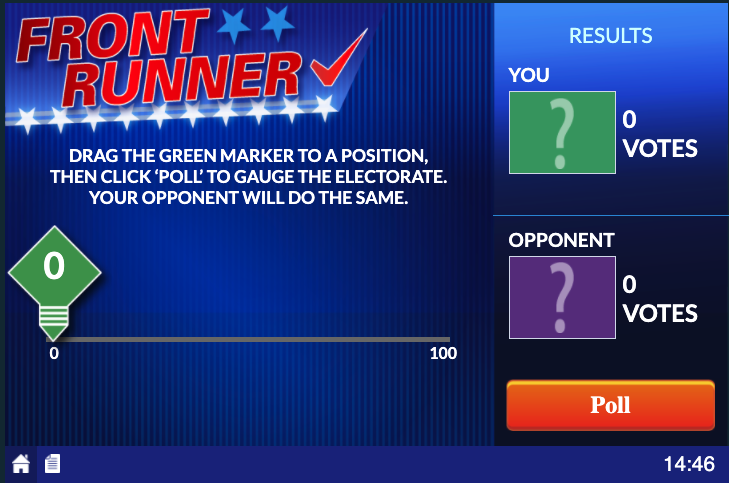While MobLab games are played in economics courses, our experiments are also employed in political science classrooms. Instructors have used MobLab for various political science courses including Intro to Political Science, Comparative Politics, and Political Game Theory. Two MobLab games frequently integrated in political science courses are the Voter Turnout Game and Two-Candidate Election Game.
Models of Voting – Why do people vote? Some people take hours out of their time to cast a vote in an election in which their individual vote will most likely not change the outcome. Explore this fascinating political question with your students and teach them about the paradox of voting with our Voter Turnout Game.
The Voter Turnout Game tells the tale of a healthy competition over which is the best sport. Students are given a preference schedule between Basketball and Soccer and placed in groups. The act of voting for their preference is costly, but students also receive a payoff if their preference wins the overall vote. What will your students choose? The group size, distribution of voting costs, and the number of students with respective sport (political) preferences are configurable parameters in the console. These parameters help illustrate the following political science concepts:
The Competition Effect The Underdog Effect The Size Effect The Voting Cost Effect
Median Voter Theorem & Spatial Voting Model – Other aspects that motivate voters to turn out are who the candidates are and their positions on key policies. In the Two Candidate Election game, you can put your students in the shoes of the competing politicians to explore the Median Voter Theorem and Spatial Voting Model. Each student simulates the role of a politician deciding where to place their policy position along a political spectrum (left to right). Simulated voters will vote for the candidate whose policy more closely reflects their political views. The student who captures the larger portion of the electorate wins.
As an instructor, you can configure the location of the median voter. Then let them explore how the interest of being elected leads to a convergence towards the median position over multiple rounds.
Would you like to learn more? Get in touch with our team. Whether you’re teaching in person, online, or both, MobLab has got you covered for interactive learning and engagement. Click here to schedule a one-on-one demo meeting.
Models of Voting – Why do people vote? Some people take hours out of their time to cast a vote in an election in which their individual vote will most likely not change the outcome. Explore this fascinating political question with your students and teach them about the paradox of voting with our Voter Turnout Game.
The Voter Turnout Game tells the tale of a healthy competition over which is the best sport. Students are given a preference schedule between Basketball and Soccer and placed in groups. The act of voting for their preference is costly, but students also receive a payoff if their preference wins the overall vote. What will your students choose? The group size, distribution of voting costs, and the number of students with respective sport (political) preferences are configurable parameters in the console. These parameters help illustrate the following political science concepts:


Median Voter Theorem & Spatial Voting Model – Other aspects that motivate voters to turn out are who the candidates are and their positions on key policies. In the Two Candidate Election game, you can put your students in the shoes of the competing politicians to explore the Median Voter Theorem and Spatial Voting Model. Each student simulates the role of a politician deciding where to place their policy position along a political spectrum (left to right). Simulated voters will vote for the candidate whose policy more closely reflects their political views. The student who captures the larger portion of the electorate wins.
As an instructor, you can configure the location of the median voter. Then let them explore how the interest of being elected leads to a convergence towards the median position over multiple rounds.


Would you like to learn more? Get in touch with our team. Whether you’re teaching in person, online, or both, MobLab has got you covered for interactive learning and engagement. Click here to schedule a one-on-one demo meeting.

